Tahiti
Destination - PacificIn the world, there are many places where cruising in a catamaran is a real dream. But just the mention of the name Tahiti makes eyes light up with a unique gleam. Tahiti really is the place where you must sail at least once in your life...
Logbook
How can we talk about Tahiti without using certain clichés? Yes, the Society Islands are a real sailing paradise. Enchanting lagoons, sublime seabeds, deserted wild anchorages, everything here is within reach for lovers of nice cruising or idyllic holidays on catamarans. And then there is also the myth, carried by the great sailors of the past, who when they arrived here, sometimes after years at sea and having put up with iron discipline aboard the Royal Navy’s ships, discovered this Eden, and the legendary Polynesian welcome. The writings of Bougainville, Cook’s descriptions, or more recently those of Moitessier or Alain Gerbault, the adventures of Melville’s heroes and even Hollywood, with its various versions of the Mutiny on the Bounty, mean that Tahiti and its islands have a special place in the imagination of all lovers of the sea and boats.
But does the myth live up to its promise? Is it worth taking the step, and going to the other side of the world to charter a cat locally? We have the answer: yes, yes, yes!
Most of the charter companies are situated at Raiatea. In the interior of the Society Islands, the sailing is finally relatively easy. The passes have better and better buoyage, and once in the lagoons, all you have to do is enjoy life and the anchorages. Obviously, in the case of a ‘relaxing’ cruise, the ideal is the departure base at Raiatea. This island and its neighbour, Tahaa, are situated in the same lagoon, which gives a multitude of anchorages without ever needing to go out onto the open sea. Crews which haven’t really got their sea legs will be delighted... But it would be a shame to limit yourself to this lagoon, as other wonders await you further on... For those who want to move even further, you can envisage going as far as Huahine or, why not, Bora Bora. This is Polynesia’s mythical island. It is one of the most visited in the archipelago. Once in the lagoon, you are free to choose your route... There are numerous anchorages and they are all as beautiful as one another. This is especially the case in the north of the lagoon, which offers absolutely wonderful underwater life, and where the water is of an indescribable blue.
Diving: You can’t go to Polynesia without enjoying the incredible spectacle of the underwater life. Although using mask, fins and snorkel is easy, and will allow you to discover a real aquarium a few dozen centimetres in front of your eyes, it would be a shame to miss the opportunity for a dive (or several) with bottles. There are many professionals available to organise these dives. Not to be missed!
Whales: In the southern winter, the humpback whales come to give birth and protect their young close to the reef, or inside the lagoons. This is a spectacle which once again, you must not miss. But you must be careful and above all, not disturb these animals and their young. Strict instructions must be respected, for both their safety and yours.
Pearls: Tahiti is famous throughout the world for its famous black pearls. There are many pearl farms in the Raiatea, Tahaa and Huahine lagoons. You can, of course, visit them and buy pearls directly, for a price which will often be more attractive than in the boutiques.
Papeete: the capital of the island is noisy, the traffic is diabolical, and it is certainly not what you expect from Polynesia. If you sail there, note that there are nevertheless some beautiful anchorages, such as between the big island and the Taiarapu peninsula (at the level of the Gauguin museum). At Moorea, although the anchorage is superb, holding is not brilliant unless you take the precaution of anchoring at the east entrance to the bay, on sand. Finally, for the record, Cook never anchored in the famous bay which bears his name, but in the neighbouring Opunohu bay, during his third voyage in Polynesia. He preferred this anchorage to the one in Matavai bay, on Tahiti. It’s up to you to see if he was right...
Practical info
Getting there:
It’s simple, it’s on the other side of the world. From Europe or the USA, you have to stop over in Los Angeles, then cross half of the Pacific. From Europe, reckon on a twenty-hour flight, not counting the stopovers...
Weather:
In Polynesia, it’s whenever you want... The trade winds blow constantly and both air and water temperatures vary little. Note that there are nevertheless two major seasons:
- from November to April, the so-called rainy season, with a hot, damp climate.
- from May to September, the dry season, a bit cooler (26 to 29°) and windy. The periods between the seasons, April-May and September-October are the best for sailing.
Sailing conditions:
The biggest danger comes from coral heads. You must pay attention to the differences in the colour of the water, which inevitably mean a change in depth or the nature of the seabed. It is therefore wise to sail with the sun high in the sky, and if possible, behind you. The setting sun is a real trap; it hides absolutely everything on the surface of the water. Otherwise, there is no tide (30cm range), and going through the passes is the only thing that requires a bit of nautical common sense...
Formalities:
Valid passport. Very few health problems, apart from ciguatera, which can be avoided quite simply by not eating fish caught in the lagoons.
Currency:
Pacific franc
Itinerary
In 8 days and 7 nights, it is possible to visit Raiatea, Huahine, Taha'a and Bora-Bora. Here is a typical cruise, departing from Raiatea:
Destinations offered by
View all the destinations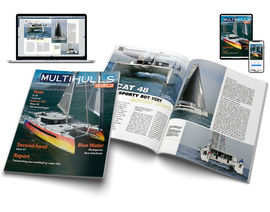
 Discover the 2025 winners!
Discover the 2025 winners! 
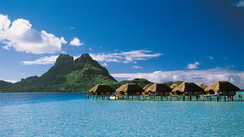
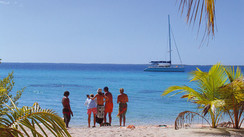
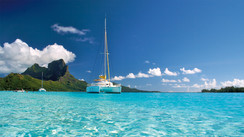
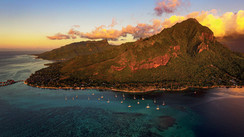
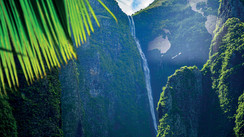
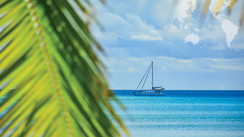





What readers think
Post a comment
No comments to show.